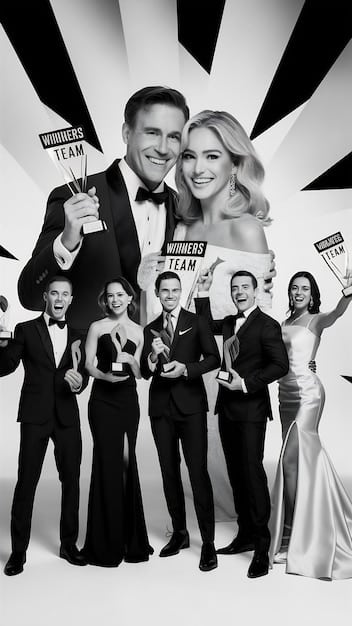Hollywood’s Diversity Push: Are Studios Meeting Representation Goals?

A new report analyzes Hollywood’s progress in meeting diversity goals, examining representation in front of and behind the camera and highlighting areas where improvements are still needed.
The entertainment industry has been under increasing pressure to diversify its talent and stories. But is this push for diversity just for show, or are studios genuinely making progress? A new report offers insights into Hollywood’s efforts to meet representation goals.
Hollywood’s Commitment to Diversity: A Closer Look
The entertainment industry has long been criticized for its lack of diversity. This section explores the factors driving Hollywood’s commitment to change, including social movements, audience demands, and evolving industry standards.
The reasons behind Hollywood’s push for diversity are multifaceted, ranging from ethical considerations to financial incentives. With a global audience demanding more inclusive storytelling, studios are recognizing the importance of reflecting the world’s diversity in their productions.
The Influence of Social Movements
Movements like #OscarsSoWhite played a significant role in highlighting the lack of diversity in the film industry. These movements sparked crucial conversations and prompted studios to re-evaluate their practices.
Audience Demand for Representation
Audiences are increasingly vocal about their desire to see themselves represented on screen. Films and shows that prioritize diversity often resonate more deeply with viewers, leading to greater success.
- Ethical Considerations: Many industry professionals believe that diversity is simply the right thing to do, striving for a more equitable and inclusive entertainment landscape.
- Financial Incentives: Diverse stories attract wider audiences, leading to increased box office revenue and streaming subscriptions.
- Evolving Standards: Organizations like the Academy of Motion Picture Arts and Sciences are implementing new standards for best picture nominations, encouraging more diverse representation.
Hollywood’s commitment to diversity is driven by a combination of ethical, social, and economic factors. As the industry evolves, it is crucial to assess whether these efforts are translating into meaningful change.
Analyzing the New Diversity Report: Key Findings
A new report provides a comprehensive analysis of diversity in Hollywood, examining representation across various platforms and demographics. This section dives into the report’s key findings, highlighting areas of progress and persistent challenges.
The report sheds light on the current state of diversity in Hollywood, offering valuable insights into which groups are well-represented and which continue to be marginalized. By examining data on screen time, hiring practices, and creative leadership, the report provides a detailed picture of the industry’s diversity landscape.

Representation in Front of the Camera
The report analyzes the representation of various racial and ethnic groups, genders, and LGBTQ+ individuals in leading and supporting roles. It assesses whether these groups are portrayed in a nuanced and authentic manner.
Diversity Behind the Camera
The report also examines the diversity of directors, writers, producers, and other key creative personnel. It investigates whether studios are providing opportunities for individuals from underrepresented backgrounds to take on leadership roles.
- Gender Representation: While progress has been made in recent years, women still face significant challenges in securing leading roles and directing opportunities.
- Racial and Ethnic Diversity: The report highlights disparities in representation for various racial and ethnic groups, with some groups consistently underrepresented on screen.
- LGBTQ+ Inclusion: The report analyzes the portrayal of LGBTQ+ characters and the inclusion of LGBTQ+ individuals in creative roles.
The report’s findings provide a nuanced understanding of diversity in Hollywood, revealing both progress and persistent challenges. By examining representation both in front of and behind the camera, the report offers valuable insights for industry stakeholders.
Progress in Gender Representation: A Step Forward?
One area where Hollywood has seen noticeable progress is in gender representation. This section explores the strides made in featuring more women in leading roles and behind the camera, while also recognizing the remaining hurdles.
While gender inequality remains a significant issue in Hollywood, there have been encouraging signs of progress in recent years. More women are taking on leading roles, directing major films, and serving as showrunners for popular television series.
More Women in Leading Roles
Films like “Wonder Woman” and “Captain Marvel” have demonstrated the box office appeal of female-led superhero movies, paving the way for more opportunities for women in action roles.
Women Behind the Camera
The number of female directors, writers, and producers has increased, although they still represent a minority in these roles. Initiatives like mentorship programs and funding opportunities are helping to create more pathways for women to enter the industry.

- Box Office Success: Films with female leads and female directors have proven to be commercially successful, challenging the outdated notion that audiences are not interested in female-driven stories.
- Industry Initiatives: Organizations and studios are implementing programs to support and promote women in the industry, addressing systemic barriers to advancement.
- Changing Perceptions: Increased visibility of women in prominent roles is helping to shift perceptions and challenge gender stereotypes in Hollywood.
While progress in gender representation is encouraging, there is still much work to be done. Women continue to face challenges in terms of pay equity, access to resources, and representation in certain genres and roles.
Racial and Ethnic Diversity: Lingering Disparities
Despite growing awareness, racial and ethnic minorities remain underrepresented in many areas of Hollywood. This section examines the disparities in representation, explores the reasons behind them, and discusses potential solutions.
While there have been some improvements in recent years, racial and ethnic minorities continue to face significant challenges in Hollywood. They are often underrepresented in leading roles, behind-the-camera positions, and executive suites.
Underrepresentation in Leading Roles
The report highlights that certain racial and ethnic groups are consistently underrepresented in leading roles, while others are often relegated to stereotypical or supporting roles.
Lack of Diversity Behind the Camera
The number of directors, writers, and producers from underrepresented backgrounds remains low, limiting the diversity of stories being told and the perspectives being shared.
- Systemic Barriers: Institutional biases and lack of access to opportunities contribute to the underrepresentation of racial and ethnic minorities in Hollywood.
- Stereotypical Portrayals: The report reveals that minorities are often portrayed in stereotypical or one-dimensional ways, perpetuating harmful stereotypes and limiting their range of roles.
- Lack of Mentorship and Support: Underrepresented individuals often lack access to mentorship and support networks, making it difficult to navigate the industry and advance their careers.
Addressing racial and ethnic disparities in Hollywood requires a multi-pronged approach, including dismantling systemic barriers, creating more opportunities for underrepresented individuals, and promoting authentic and nuanced portrayals of diverse communities.
LGBTQ+ Inclusion: Telling Authentic Stories
The portrayal of LGBTQ+ characters and the inclusion of LGBTQ+ individuals in creative roles are crucial aspects of diversity. This section examines Hollywood’s progress in LGBTQ+ inclusion, highlighting both successes and areas for improvement.
In recent years, there has been a growing demand for more authentic and nuanced portrayals of LGBTQ+ characters in film and television. Studios are increasingly recognizing the importance of telling stories that reflect the diversity of the LGBTQ+ community.
More LGBTQ+ Characters on Screen
The report notes an increase in the number of LGBTQ+ characters appearing in film and television, although representation still lags behind the actual percentage of LGBTQ+ individuals in the population.
LGBTQ+ Individuals in Creative Roles
The inclusion of LGBTQ+ individuals in writing rooms, directing roles, and producing positions is also on the rise, leading to more authentic and nuanced storytelling.
- Authentic Storytelling: It is crucial that LGBTQ+ characters are portrayed with depth and complexity, avoiding stereotypes and clichés.
- Representation Matters: Seeing themselves represented on screen can be incredibly empowering for LGBTQ+ individuals, fostering a sense of belonging and validation.
- Beyond Tokenism: It is important that LGBTQ+ characters are not simply token additions but are integral to the story and have meaningful arcs.
While progress has been made in LGBTQ+ inclusion, there is still work to be done to ensure that LGBTQ+ stories are told authentically and that LGBTQ+ individuals have equal opportunities in the entertainment industry.
The Impact of Diversity Initiatives: Are They Working?
Hollywood has implemented various diversity initiatives aimed at increasing representation. This section assesses the effectiveness of these initiatives, examining whether they are leading to meaningful change or simply serving as public relations tools.
Many studios have launched diversity initiatives, including fellowship programs, mentorship opportunities, and inclusion riders. The effectiveness of these initiatives varies, and it is crucial to evaluate whether they are truly driving change or simply serving as window dressing.
Fellowship Programs and Mentorship Opportunities
These programs aim to provide individuals from underrepresented backgrounds with access to training, mentorship, and networking opportunities.
Inclusion Riders
Inclusion riders are contractual clauses that require a certain level of diversity in casting and crew. Their effectiveness depends on how consistently they are implemented and enforced.
- Meaningful Impact: Initiatives must be designed to address systemic barriers and provide sustained support for underrepresented individuals.
- Accountability and Transparency: Studios must be held accountable for their diversity goals and provide transparent data on their progress.
- Long-Term Commitment: Diversity initiatives should not be one-off efforts but rather part of a long-term commitment to creating a more inclusive industry.
The impact of diversity initiatives depends on their design, implementation, and long-term commitment. It is crucial to critically evaluate these initiatives to ensure that they are truly contributing to a more diverse and equitable entertainment industry.
| Key Point | Brief Description |
|---|---|
| 🎬 Diversity Initiatives | Efforts by studios to promote inclusion. |
| 🌟 Gender Representation | Increasing women in leading roles. |
| 🌍 Ethnic Diversity | Representation of various ethnic groups. |
| 🏳️🌈 LGBTQ+ Inclusion | Authentic LGBTQ+ stories on screen. |
FAQ
▼
The report primarily analyzes the representation of various demographic groups in Hollywood, examining progress and persistent challenges in achieving diversity in front of and behind the camera.
▼
The report indicates progress in featuring more women in leading roles, but pay equity and access to resources remain significant hurdles for women in the entertainment industry.
▼
The report examines disparities in representation for different racial and ethnic groups, noting underrepresentation in leading roles and a lack of diversity among directors, writers, and producers.
▼
The report acknowledges an increase in LGBTQ+ characters and individuals in creative roles but emphasizes the need for authentic storytelling and representation beyond tokenism to ensure meaningful inclusion.
▼
The report suggests that the impact of diversity initiatives varies, highlighting the importance of addressing systemic barriers and maintaining long-term commitment to achieve meaningful change and avoid merely serving as public relations efforts.
Conclusion
As Hollywood continues its journey toward greater diversity and inclusion, the new report serves as a valuable tool for assessing progress and identifying areas where further effort is needed. While strides have been made in certain areas, such as gender representation, persistent disparities remain for racial and ethnic minorities and LGBTQ+ individuals. It is crucial for studios to implement and enforce meaningful diversity initiatives, ensuring that they are not just for show but rather contribute to a more equitable and representative entertainment industry.





